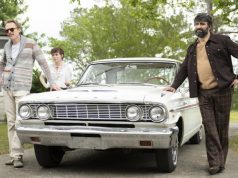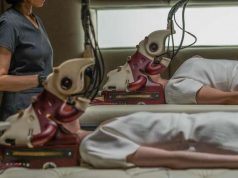There are no original ideas in “Silent House,” and not just because it’s a remake. The 2010 Uruguayan film that spawned it, barely seen outside the festival circuit, is reportedly composed of familiar ingredients, too. But so are the scary stories that you tell around campfires, and plenty of those get the job done, their simplicity notwithstanding. It’s all in the execution.
“Silent House” is executed with unnerving skill, practically a master class in how to tell a spooky-house story. Start with a vulnerable female; put her in a large, rural house with creepy noises; keep daylight to a minimum; let the pants-wetting ensue. Directors Chris Kentis and Laura Lau — the husband-and-wife duo who made “Open Water” — don’t reinvent the horror game, but they play it very well.
The story is told in real time, and even appears to have been shot in one continuous, unbroken take. (It probably wasn’t.) At the center of nearly every frame is Sarah (Elizabeth Olsen), a young woman who spent her childhood summers at this charming old house in the woods. Now suffering from the ravages of age and vandalism, the house is being prepped for sale by Sarah’s father (Adam Trese) and uncle Peter (Eric Sheffer Stevens). Sarah is on hand to help with the repairs.
Unexplained sounds emanate from upstairs. The house is big and has been unoccupied for years; it could be anything from raccoons to squatters. Sophia (Julia Taylor Ross), a young woman who lives nearby and played with Sarah when they were both little, stops over to say hello, but Sarah isn’t sure she remembers her. Sarah’s father is demanding, her uncle vaguely inappropriate, the general atmosphere slightly puzzling.
From these simple ingredients comes a hair-raising, armrest-clutching, close-the-closet-door-before-you-go-to-sleep suspense thriller. By shooting the film in one long take (or at least appearing to do so) and focusing on one character, the directors achieve a greater degree of intimacy — a greater sense of “you are there” — than a traditional structure would allow. (The Uruguayan film, by Gustavo Hernandez, used the same technique, though I’m told there are significant differences in the plot.) Kentis and Lau use the naturalistic setting to their advantage. When Sarah walks into a dimly lit room, for example, it takes us as long to make out the shapes as it does her. We don’t know anything that she doesn’t.
Elizabeth Olsen, the heretofore-unknown younger sister of Mary-Kate and Ashley, handles the daunting task of carrying an entire scary movie on her shoulders with impressive skill. She is called upon to do a lot of crying, screaming, and cowering, and while the story has her hiding under tables and beds a few too many times, she is never less than convincing. Sarah is the quintessential heroine for this type of movie: vulnerable but not weak, strong but still feminine.
The actors who play Sarah’s father and uncle aren’t nearly as good, resulting in a few unintentionally funny moments. (I note that the acting was the major problem with “Open Water,” too.) It’s also possible that Kentis and Lau employ too many “jump scares,” and that the ominous musical score is overused.
I’m also disappointed by the film’s usage of the old “This really happened on such-and-such a date!” framing device. This isn’t a true story; no one believes you when you say it is; insulting our intelligence doesn’t make the film any scarier.
But I’m in awe of the directors’ ability to pull off the single-take trick. Even assuming that it was actually three or four separate shots, each one is full of movement and activity, taking place on three levels of a real house; the logistics alone set a movie nerd’s heart a-flutter. There are several nifty sleight-of-hand tricks that could only have been done live, without post-production assistance. Any weaknesses in the film are more than outweighed by the smooth confidence with which Kentis and Lau tell their goosebumpy little story.
B+ (1 hr., 26 min.; )





